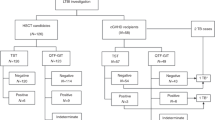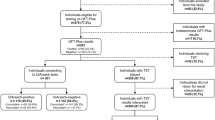Abstract
The tuberculin skin test (TST) and QuantiFERON-TB-Gold-In-tube (QFTGIT) are adjunctive tests used in the diagnosis of pediatric tuberculosis (TB). Neither test can rule out TB; however, a positive test usually triggers preventive treatment in TB contacts aged <5 years. TST and QFTGIT can give divergent results and it is unclear how discordant results should be interpreted in terms of TB risk and preventive treatment. To understand the immune processes underlying concordant or discordant TST and QFTGIT results, we analyzed immune responses in children from Palamaner Taluk in India (a TB-endemic region with routine neonatal BCG vaccination) who were referred to a TB case verification ward on suspicion of TB. Two hundred and ten children aged <3 years were classified according to their TST and QFTGIT results, and their immune responses analyzed by dual-colour-Reverse-Transcriptase-Multiple-Ligation-dependent-Probe-Amplification, using a panel of 45 genes and a 10-plex antigen-specific enzyme-linked immunosorbent assay. We show that immune biomarkers FPR1, TNFRSF1A and interferon (IFN)-γ are upregulated (all P<0.05) in concordant test-positive children, whereas BPI is downregulated (P<0.05). In contrast, SEC14L1 (P=0.034) and Interferon gamma-induced protein 10 (IP-10) (P=0.001) are differentially expressed between the TST+QFTGIT− /TST−QFTGIT+ groups. Known TB exposure was more frequent in concordant positive children and results were consistent with elevated expression of genes associated with inflammatory responses. Children with discordant test results displayed a mixed profile with activation of both pro- and anti-inflammatory markers. TST and/or QFTGIT positivity appears to reflect distinct but overlapping aspects of host immunity.
This is a preview of subscription content, access via your institution
Access options
Subscribe to this journal
Receive 6 digital issues and online access to articles
$119.00 per year
only $19.83 per issue
Buy this article
- Purchase on Springer Link
- Instant access to full article PDF
Prices may be subject to local taxes which are calculated during checkout





Similar content being viewed by others
References
Rangaka MX, Wilkinson KA, Glynn JR, Ling D, Menzies D, Mwansa-Kambafwile J et al. Predictive value of interferon-gamma release assays for incident active tuberculosis: a systematic review and meta-analysis. Lancet Infect Dis 2012; 12: 45–55.
WHOWorld Health Organization Global Tuberculosis Report, 2012.
Marais BJ, Graham SM, Maeurer M, Zumla A . Progress and challenges in childhood tuberculosis. Lancet Infect Dis 2013; 13: 287–289.
Marais BJ, Gie RP, Schaaf HS, Hesseling AC, Enarson DA, Beyers N . The spectrum of disease in children treated for tuberculosis in a highly endemic area. Int J Tuberc Lung Dis 2006; 10: 732–738.
Perez-Velez CM, Marais BJ . Tuberculosis in children. N Engl J Med 2012; 367: 348–361.
CDC. Updated Guidelines for Using Interferon Gamma Release Assays to Detect Mycobacterium tuberculosis Infection, United States. MMWR 2010; 59: 1–25.
Menzies D, Pai M, Comstock G . Meta-analysis: new tests for the diagnosis of latent tuberculosis infection: areas of uncertainty and recommendations for research. Ann Intern Med 2007; 146: 340–354.
Mandalakas AM, Detjen AK, Hesseling AC, Benedetti A, Menzies D . Interferon-gamma release assays and childhood tuberculosis: systematic review and meta-analysis. Int J Tuberc Lung Dis 2011; 15: 1018–1032.
Hesseling AC, Mandalakas AM, Kirchner HL, Chegou NN, Marais BJ, Stanley K et al. Highly discordant T cell responses in individuals with recent exposure to household tuberculosis. Thorax 2009; 64: 840–846.
Dhanasekaran S, Jenum S, Stavrum R, Ritz C, Faurholt-Jepsen D, Kenneth J et al. Identification of biomarkers for Mycobacterium tuberculosis infection and disease in BCG-vaccinated young children in Southern India. Genes Immun 2013; 14: 356–364.
Lagrange PH, Thangaraj SK, Dayal R, Deshpande A, Ganguly NK, Girardi E et al. A toolbox for tuberculosis (TB) diagnosis: an Indian multicentric study (2006-2008). Evaluation of QuantiFERON-TB gold in tube for TB diagnosis. PLoS One 2013; 8: e73579.
Lodha R, Mukherjee A, Saini D, Saini S, Singh V, Singh S et al. Role of the QuantiFERON(R)-TB Gold In-Tube test in the diagnosis of intrathoracic childhood tuberculosis. Int J Tuberc Lung Dis 2013; 17: 1383–1388.
Wassie L, Aseffa A, Abebe M, Gebeyehu MZ, Zewdie M, Mihret A et al. Parasitic infection may be associated with discordant responses to QuantiFERON and tuberculin skin test in apparently healthy children and adolescents in a tuberculosis endemic setting, Ethiopia. BMC Infect Dis 2013; 13: 265.
Brandt L, Feino Cunha J, Weinreich Olsen A, Chilima B, Hirsch P, Appelberg R et al. Failure of the Mycobacterium bovis BCG vaccine: some species of environmental mycobacteria block multiplication of BCG and induction of protective immunity to tuberculosis. Infect Immun 2002; 70: 672–678.
Joosten SA, Goeman JJ, Sutherland JS, Opmeer L, de Boer KG, Jacobsen M et al. Identification of biomarkers for tuberculosis disease using a novel dual-color RT-MLPA assay. Genes Immun 2012; 13: 71–82.
Maertzdorf J, Repsilber D, Parida SK, Stanley K, Roberts T, Black G et al. Human gene expression profiles of susceptibility and resistance in tuberculosis. Genes Immun 2011; 12: 15–22.
Wallis RS, Kim P, Cole S, Hanna D, Andrade BB, Maeurer M et al. Tuberculosis biomarkers discovery: developments, needs, and challenges. Lancet Infect Dis 2013; 13: 362–372.
Green AM, Difazio R, Flynn JL . IFN-gamma from CD4 T cells is essential for host survival and enhances CD8 T cell function during Mycobacterium tuberculosis infection. J Immunol 2013; 190: 270–277.
Cavalcanti YV, Brelaz MC, Neves JK, Ferraz JC, Pereira VR . Role of TNF-alpha, IFN-gamma, and IL-10 in the development of pulmonary tuberculosis. Pulmonary Med 2012; 2012: 745483.
Abebe M, Doherty TM, Wassie L, Aseffa A, Bobosha K, Demissie A et al. Expression of apoptosis-related genes in an Ethiopian cohort study correlates with tuberculosis clinical status. Eur J Immunol 2010; 40: 291–301.
Migeotte I, Communi D, Parmentier M . Formyl peptide receptors: a promiscuous subfamily of G protein-coupled receptors controlling immune responses. Cytokine Growth Factor Rev 2006; 17: 501–519.
Ye RD, Boulay F, Wang JM, Dahlgren C, Gerard C, Parmentier M et al. International Union of Basic and Clinical Pharmacology. LXXIII. Nomenclature for the formyl peptide receptor (FPR) family. Pharmacol Rev 2009; 61: 119–161.
Beigier-Bompadre M, Aleman M, Barrionuevo P, Franco MC, Rubel CJ, Sasiain Mdel C et al. Monocytes and neutrophils from tuberculosis patients are insensitive to anti-inflammatory effects triggered by the prototypic formyl peptide N-formyl-methionyl-leucyl-phenylalanine (FMLP). Clin Exp Immunol 2003; 133: 267–274.
Schultz H, Weiss JP . The bactericidal/permeability-increasing protein (BPI) in infection and inflammatory disease. Clinica Chim Acta 2007; 384: 12–23.
Krummel B, Strassburg A, Ernst M, Reiling N, Eker B, Rath H et al. Potential role for IL-2 ELISpot in differentiating recent and remote infection in tuberculosis contact tracing. PLoS One 2010; 5: e11670.
Sakamoto K . The pathology of Mycobacterium tuberculosis infection. Vet Pathol 2012; 49: 423–439.
Harris J, De Haro SA, Master SS, Keane J, Roberts EA, Delgado M et al. T helper 2 cytokines inhibit autophagic control of intracellular Mycobacterium tuberculosis. Immunity 2007; 27: 505–517.
Toossi Z, Gogate P, Shiratsuchi H, Young T, Ellner JJ . Enhanced production of TGF-beta by blood monocytes from patients with active tuberculosis and presence of TGF-beta in tuberculous granulomatous lung lesions. J Immunol 1995; 154: 465–473.
Whittaker E, Gordon A, Kampmann B . Is IP-10 a better biomarker for active and latent tuberculosis in children than IFNgamma? PLoS One 2008; 3: e3901.
Li MT, Di W, Xu H, Yang YK, Chen HW, Zhang FX et al. Negative regulation of RIG-I-mediated innate antiviral signaling by SEC14L1. J Virol 2013; 87: 10037–10046.
Agell L, Hernandez S, Nonell L, Lorenzo M, Puigdecanet E, de Muga S et al. A 12-gene expression signature is associated with aggressive histological in prostate cancer: SEC14L1 and TCEB1 genes are potential markers of progression. Am J Pathol 2012; 181: 1585–1594.
Nicol MP, Davies MA, Wood K, Hatherill M, Workman L, Hawkridge A et al. Comparison of T-SPOT.TB assay and tuberculin skin test for the evaluation of young children at high risk for tuberculosis in a community setting. Pediatrics 2009; 123: 38–43.
Liebeschuetz S, Bamber S, Ewer K, Deeks J, Pathan AA, Lalvani A . Diagnosis of tuberculosis in South African children with a T-cell-based assay: a prospective cohort study. Lancet 2004; 364: 2196–2203.
Bachani D, Sogarwal R . National response to HIV/AIDS in India. Indian j Community Med 2010; 35: 469–472.
Chandra RK . Nutrition and the immune system: an introduction. Am J Clin Nutr 1997; 66: 460S–463S.
Diel R, Loddenkemper R, Meywald-Walter K, Niemann S, Nienhaus A . Predictive value of a whole blood IFN-gamma assay for the development of active tuberculosis disease after recent infection with Mycobacterium tuberculosis. Am J Respir Crit Care Med 2008; 177: 1164–1170.
Mengatto L, Chiani Y, Imaz MS . Evaluation of rapid alternative methods for drug susceptibility testing in clinical isolates of Mycobacterium tuberculosis. Mem Inst Oswaldo Cruz 2006; 101: 535–542.
Working Group on Tuberculosis IAoP. Consensus statement on childhood tuberculosis. Indian Pediatr 2010; 47: 41–55.
Basu Roy R, Sotgiu G, Altet-Gomez N, Tsolia M, Ruga E, Velizarova S et al. Identifying predictors of interferon-gamma release assay results in pediatric latent tuberculosis: a protective role of bacillus Calmette-Guerin?: a pTB-NET collaborative study. Am J Respir Crit Care Med 2012; 186: 378–384.
Wachtman LM, Miller AD, Xia D, Curran EH, Mansfield KG . Colonization with nontuberculous mycobacteria is associated with positive tuberculin skin test reactions in the common marmoset (Callithrix jacchus). Comp Med 2011; 61: 278–284.
Acknowledgements
We thank Aud Eliassen at the sequencing laboratory at Haukeland University Hospital, Bergen, Norway. We thank Diana Mahelai and Syed Fazil Ahamed for their technical assistance, and Sumithra Selvan, Nelson Jesuraj and Naveen Kumar Kellengere at St John's Research Institute, Bangalore, for epidemiological data and statistical assistance. QFT-GIT tests were in part supported by FIND. This study is conducted as part of the Indo-Norway research program. This study was supported by the Research Council of Norway (Grants 179342, 192534 and 196362), University of Bergen, Aeras, USA, and St John’s Research Institute, India.
Author information
Authors and Affiliations
Consortia
Corresponding author
Ethics declarations
Competing interests
The authors declare no conflict of interest.
Additional information
Members of the TB Trials Study Group: Doherty T M, Grewal H M S, Hesseling A C, Jacob A, Jahnsen F, Kenneth J, Srinivasan K, Lindtjørn B, Macaden R, Nelson J, Sumithra S, Vaz M, Cardenas V
Supplementary Information accompanies this paper on Genes and Immunity website
Rights and permissions
About this article
Cite this article
Dhanasekaran, S., Jenum, S., Stavrum, R. et al. Concordant or discordant results by the tuberculin skin test and the quantiFERON-TB test in children reflect immune biomarker profiles. Genes Immun 15, 265–274 (2014). https://doi.org/10.1038/gene.2014.13
Received:
Revised:
Accepted:
Published:
Issue Date:
DOI: https://doi.org/10.1038/gene.2014.13



